Kanayi Kunhiraman, the master sculptor of public spaces in Kerala, wants his home state to become the capital of painting and sculpting. If Raja Ravi Varma made painting popular in Kerala, Kunhiraman brought sculpting to the masses. Kunhiraman presented Kerala a fresh cultural awareness which was rooted in nature. His sculptures in Malampuzha and Shamkhumukham have become part of the landscape and the lore.
A disciple of K.C.S. Paniker, Kunhiraman has a variety of sculptures in his oeuvre, abstract and realist, bust and full size. He built legendary sculptures in public spaces in return for only a mason’s wage. Not even once did he care to exhibit his works in an art gallery. A tour of the artist’s life and vision.
Let us start from your childhood
My mother was a humble woman with not much of an education. She could read. That’s all. Those days, marriages were fixed by the families without the woman and man meeting each other. My mother’s father, Kuttamath, was an ayurvedic healer. My father had three wives and 12 children. I was the oldest. My father was a rowdy. His father was a serf but we gradually occupied the entire plot of land.
Almost every day my father would go to the court at Kanhangad with the regularity of an office-goer. He wouldn’t listen to anyone. In fact, anyone who did not approve of him was an enemy for him.
He cited Bhagavad Gita to convince himself that his duty was to eliminate the enemy. He had a brush with the feudal overlords of Neela Mana and Bhasmamvari Mana. He organised a group of fellow-tenants and attacked the Bhasmamvari Mana. They tied up the Namboothiri and robbed the granary. That was the first reaction against feudalism in our land. Policemen intimidated my father but they could not touch him.
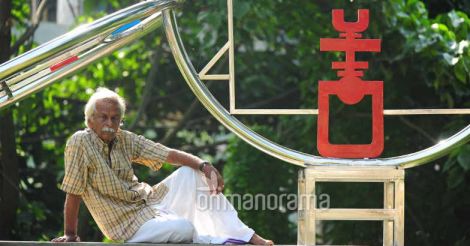 Kanayi Kunhiraman with one of his works in front of the Public Library in Kottayam. Photo: Manorama
Kanayi Kunhiraman with one of his works in front of the Public Library in Kottayam. Photo: ManoramaThe Namboothiris, however, were hell-bent on revenge. They tried for months to get even with my father. They finally hired a strongman who had retired from the military. Armed with a knife, he challenged my father at the Cheruvathur railway station. They duelled, throwing each other onto the railway track. People were too terrified to intervene.
My father grabbed the knife from the strongman and stabbed him several times until his intestines were spilled out. This is among my first memories of my father.
Were caste differences prevalent then?
Not at all! People used to help each other. A Muslim woman used to help at our home. She would take things from our house and bring us stuff from her house. We were not aware of religion or caste then. Today, that has become corrupted. The corruption of politics worsened the situation.
You have written about the beauty of the nude body. Female body was a means for you to speak about nature and spirituality. What is your first experience of nudity?
In my childhood, everyone was supposed to do agricultural work. My father had a younger sister called Patta (Parvathi). She was rowdier than my father. She had four children but was living with us due to some difference with her husband. She was the lady of the house and would get things done by swearing at others. We would start work at 5 in the morning.
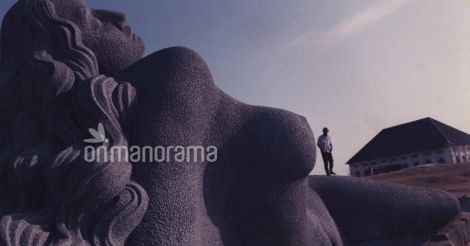
No one used to wear blouses that time. Everyone would be half-naked. After work, all of us would go to the same pond to wash up. Women on one side and men on the other. Nobody thought anything vulgar about it. I would peep at people when they bathe, maybe because I am an artist. They would stand waist deep in water, remove the only towel around their waist and dry their hair. Then they would wrap the same towel and go home. No one would stare at anyone. Where is that culture now?
Those days were calmer, with fewer cases of rape, robbery and vulgar speech. How did we land up here?
We did not have a written culture. We relied on oral traditions. The degradation of values started with the shift towards the written culture. Our society will improve only when we return to our oral traditions. I try to bring back oral traditions.
Is sculpting as old as oral traditions?
Our oldest sculpture is 30,000 years old. It is in the Cave of Altamira.
You have done sculptures titled ‘Amma’ in 1960, 1964 and 1965. Why do you explore motherhood?
My mother loved me the most. We are in search of love. The love and security I received from mother I have not got from anyone else.
Do the huge sculptures suit Kerala’s art tradition?
I don’t know why I like to make huge sculptures. I want to chisel at huge boulders. You give me a gigantic rock or a hillock and just enough money to cover my expenses, and I will keep chiselling away at it.
I am not comfortable doing a small sculpture. I used to work on six or seven feet sculptures even when I was a student in Madras. I was the first one in the department to do a big sculpture. India’s history is dominated by dwarf sculpting. K.C.S. Paniker and others have mostly done small sculptures.
I have asked myself why I like big sculptures. The 'Theyyam' and 'Thira' performances of my childhood are still fresh in my mind. Our god, our culture, everything is colossal. Shape is signified by size. The Theyyam mask is 25 feet high. This is unparalleled.
A modest Malayan or Vannan (two lower castes in Kerala) is transformed to god when he wears this crown. Everybody worships him. The man who first envisaged the shape of Theyyam is the true modern sculptor.
Western art is science. Our art draws from nature’s resources. We make a human body into a statue with costumes and ornaments. An ordinary man is changed into a gigantic shape.
Dazzling colours were the only entertainment those days. Everyone in the house would go to the festival. The Theyyam performance starts late at night, after the customary songs are finished. The performance accompanied by fire is fantastic.
Their life is miserable after that.
They would fall ill. They were paid not in money but rice and other things. Those days are passé.
What is your reward when you sculpt?
Talk of reward and everyone thinks about monetary reward. My asset is artistic value and you cannot put a price to it. I live that value and search for it.
When was your wedding?
Actually, you should ask my wife.
Your wife is always with you and the sculptures. Nalini wanders along with the sculptor.
I had told her at the time of our wedding that ours is going to be a life like that of Ram, in exile. I was a professor when we got married. We did not have any savings. She asked back, “Will I end up in Sita’s position.” I promised her that I will not do any such foolish thing. She cares for me. She loves the sculpture and the sculptor alike. She is always with me when I do a sculpture. I never had to bother about anything. She takes care of everything.
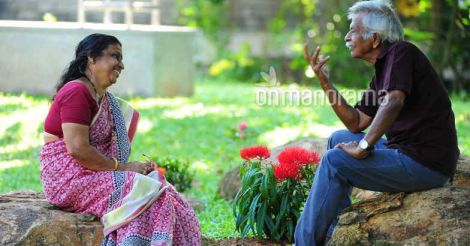 Kanayi Kunhiraman with his wife Nalini. Photo: Manorama
Kanayi Kunhiraman with his wife Nalini. Photo: ManoramaMarriage is institutional. Does it have a male nature?
That is true. Life is a sharing. So there is no dominance between us.
A universal vision through mother, the writing of that vision on stone…is it the way of your sculpting?
We put sculptures, not paintings, in the sanctum sanctorum. Idol worship is not a good thing. That leads to many other superstitions. God does not have a shape or smell or colour. That is a force spread all over. That is what the Upanishads and Quran say.
When someone renounces something, how can you call it torture?
That is a minority. The problem with them is they will always try to lead others to the right path. This minority is always trying to control the world.
Values are created by the minority, not majority. Minority is energy and majority mass. Talent is energy and energy rules the world.
Then what is our latent taste?
When two persons combine, it is not latent. Anything latent is nature’s gift.
You have lived in many places for sculpting. Can you tell us about those experiences?
The most painful was my days in Malampuzha to sculpt 'Yakshi'.
Did you inherit this fearlessness from your father?
Yes. I got it from my father. He never feared anyone.
What would have happened to Kerala’s sculpting but for you?
It wouldn’t have grown so much. Nobody would have taken such risks to sculpt. I study nature before sculpting. I will not do anything that hurts nature.
You changed the concept of a trophy.
Trophy used to be a lamp or cup earlier. Why not a sculpture, I thought. That would be a boost to sculpting. That became a success.
Why do you criticise Kochi Muziris Biennale?
It was me who gave that idea and encouraged the concept. The National Exhibition first came to Kerala when I was the chairman of the Lalit Kala Academy. I had also arranged to host a part of the Triennale International.
After my tenure, people wanted Kerala to conduct an international exhibition. I went along but didn’t give my sculptures.
Many including M.A.Baby asked me why I was cross after starting it. I was not cross. But I don’t compromise on money matters. Kerala has painters who cannot afford a canvas. There are serious artists, geniuses among them, struggling for money. You give them money. Let them buy canvas and create art. You buy those paintings and give them the money. It was proposed to spend Rs 73 crore for the biennale. That’s pointless. I disagreed on money matters.
Mukkola Perumal has been studied in many dimensions. Can you talk about it?
Mukkola Perumal is entering its 43 years. When Dhanraj Bhagat came to Kerala, he saw the sculpture and congratulated me. He said there was no such sculpture anywhere in India. That was encouraging.
You are well-versed in traditional and modern art. How far have your teachers helped in it?
My most inspiring teacher was Reg Butler. He was one of the first in the world to do welded sculptures. I was the first one to do it in South India, in 1957. That was not noticed then. Had it been in Delhi, the work would have been recognised.
More about your teachers…
K.C.S. Paniker, Dhanapalan, Reg Butler…there are many who have tried to improve me. Teachers here are different in their attitude from those abroad.
About Madan Thara?
Madan Thara is sun worship. There is no religion or caste or anything. Anybody can go there. I did it in a modern art form. Minimal art is a major stream in modern art. I made it in this form. For us, it is a place of worship. For a Westerner, it is minimal art.
The sculpture in Mullakkal Temple in Alappuzha is in modern art form. You have not done any such thing after that.
Astrologists proposed a temple at Mullakkal. They asked the astrologers who should make the sculpture. They finally zeroed in on Kanayi.
Girirajan and Govindan of Bhima Brothers urged me to do a sculpture but I refused. They offered to pay me whatever I ask for. I have not asked for anything. When the temple makers insisted, I agreed.
About full-size bronze sculptures?
When I came back to Kerala, everyone used to do sculptures in Madras. Why can’t we do it here, I thought. I was asked to sculpt R. Shankar in Kollam. Devan discouraged me, saying moulding was not true art. I could not convince them. Then I was approached to make a sculpture of Netaji. I made a model and showed it to the then director of Gorky Bhavan, Kannampilly, and others. They thought it was excellent. I went to Mannar and got some craftsmen to mould the sculpture. I trained them in it. I had learned it in England. That turned out very well.
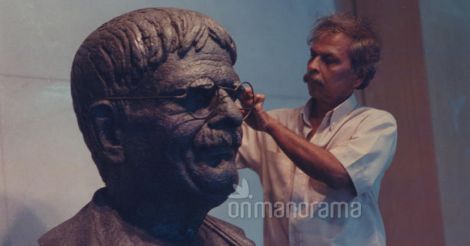 Kanayi Kunhiraman gives final touches to the bust of K.C. Mammen Mappilai. Photo: Manorama
Kanayi Kunhiraman gives final touches to the bust of K.C. Mammen Mappilai. Photo: ManoramaCan you talk about the creation of bronze sculptures?
When someone asks me to do a bronze sculpture, I do my homework. We would feel that a certain approach would be good. That could be an intuition. I don’t look for Vaastu when I do a sculpture. Somehow, it becomes accurate.
What is the philosophy behind Kerala’s sculpture art? What is its future?
Kerala has a shortage of raw materials. The other states have a lot of granite and marble. Our state has emerged from the sea. There are no stones here. So sculptures are mostly done on wood.
Apart from the sculptor’s self-realisation, what do these sculptures give to society?
My sculpture is an educational method. The language is three-dimensional. My sculptures do whatever a three-dimensional language can do to society. This is not only my self-realization.
You have done sculptures, statues and idols. How do they differ?
All of them speak the language of art. They are the same, like the same language performing multiple functions. An idol is a symbol. We cover our ideas in a symbol. It has no relation to reality.
There is a creative process involved in sculptures. There is liberty in it. The sculpture is my world.
When you make a statue, you have to make the inner self. You have to bring out the inner personality. You have to study everything about the subject.
Sculptors are usually self-centred. How does it affect their art?
It destroys art. There is no artist. There is only art.
**Can you tell us about the Akshara Shilpam you have just finished in Kottayam?
A Sculpture of Letters in the City of Letters. Kottayam Public Library president Abraham Itticheriya has been persuading me to do it for five years.
















































 at a workshop by artist John Baby (left) at the art room of the Kochi-Muziris Biennale in December.jpg.image.160.84.jpg)






















.jpg.image.160.84.jpg)

.jpg.image.160.84.jpg)













































































































































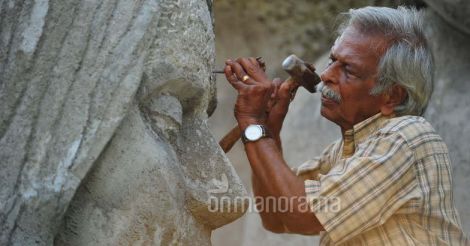 Kanayi Kunhiraman works on the 'Aksharasilpam' in front of the Public Library in Kottayam. Photo: Manorama
Kanayi Kunhiraman works on the 'Aksharasilpam' in front of the Public Library in Kottayam. Photo: Manorama
Disclaimer
The comments posted here/below/in the given space are not on behalf of Manorama. The person posting the comment will be in sole ownership of its responsibility. According to the central government's IT rules, obscene or offensive statement made against a person, religion, community or nation is a punishable offense, and legal action would be taken against people who indulge in such activities.